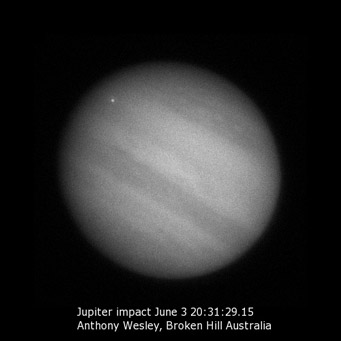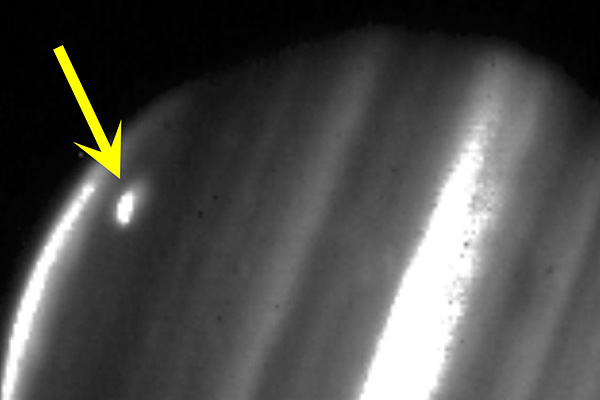
© Anthony WesleyAnother impact? This single frame from a short video shows Jupiter sporting a bright "fireball" at upper left.
Not just one but two veteran planetary imagers caught the shots of a lifetime on June 3rd, when they both video recorded a tiny, brilliant flare on Jupiter swelling and fading around 20:31 Universal Time. The flare brightened and faded in less than two seconds. Its progress is recorded on many frames of each video.
The flare may have looked small from Earth, but it must have been titanic to be seen at all from Jupiter's distance - and on Jupiter's daylit side. It was presumably the impact of an asteroid or comet nucleus.
Veteran planetary imager Anthony Wesley, an amateur in Murrumbateman, Australia, was recording in red light at the lucky moment in order to create another of his many stacked-video color stills of Jupiter. The impact "doesn't seem to have left any mark, so it probably burned up in the upper atmosphere before it reached the cloud deck," suggests Wesley.
At the same moment, Christopher Go was imaging Jupiter several thousand miles away in the Phillipines. He was taking blue frames at the moment of impact.
Go's video of the Jupiter impact provides ironclad confirmation of the event!
The flare occurred at longitude 248.8° in Jupiter's System I, 342.7° in System II, and 159.4° in System III. The latitude is 16° south. This region should be visible from about 4:00 to 6:30 June 4th UT, favoring observers in Europe and Africa when Jupiter is up before dawn. The impact site will return to good view about every 9 hours 56 minutes thereafter.
Wesley is well known for discovering an impact on Jupiter last July 19 - by the dark mark it left behind - spurring telescopes around the world (and above it) to study the serendipitous event.
Stay tuned for updates!


